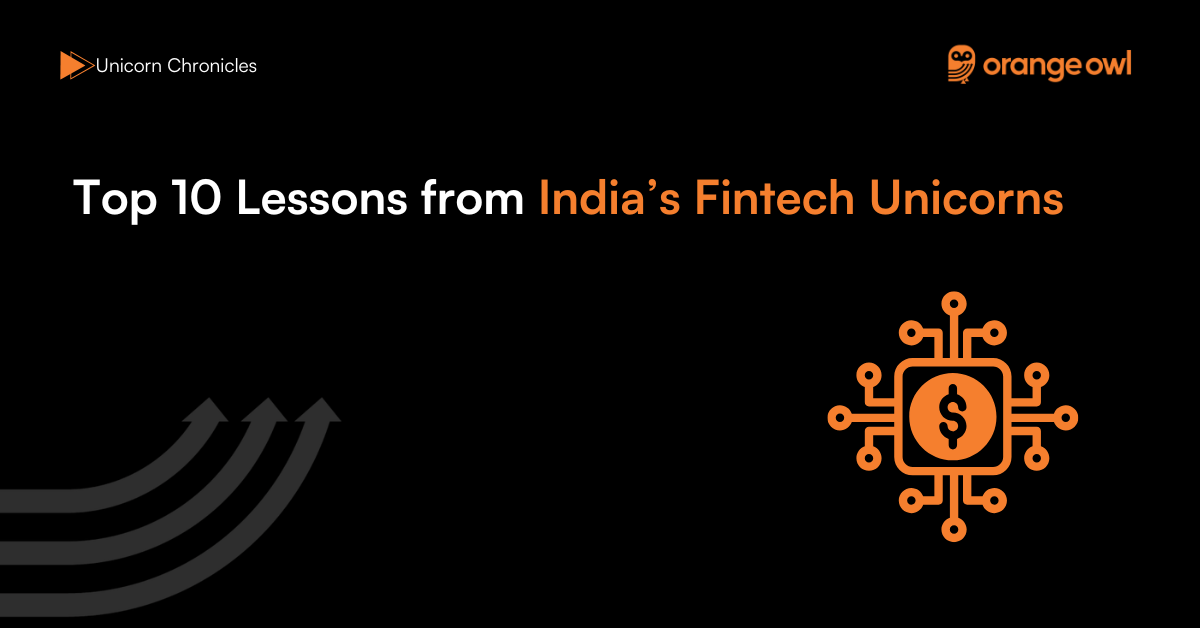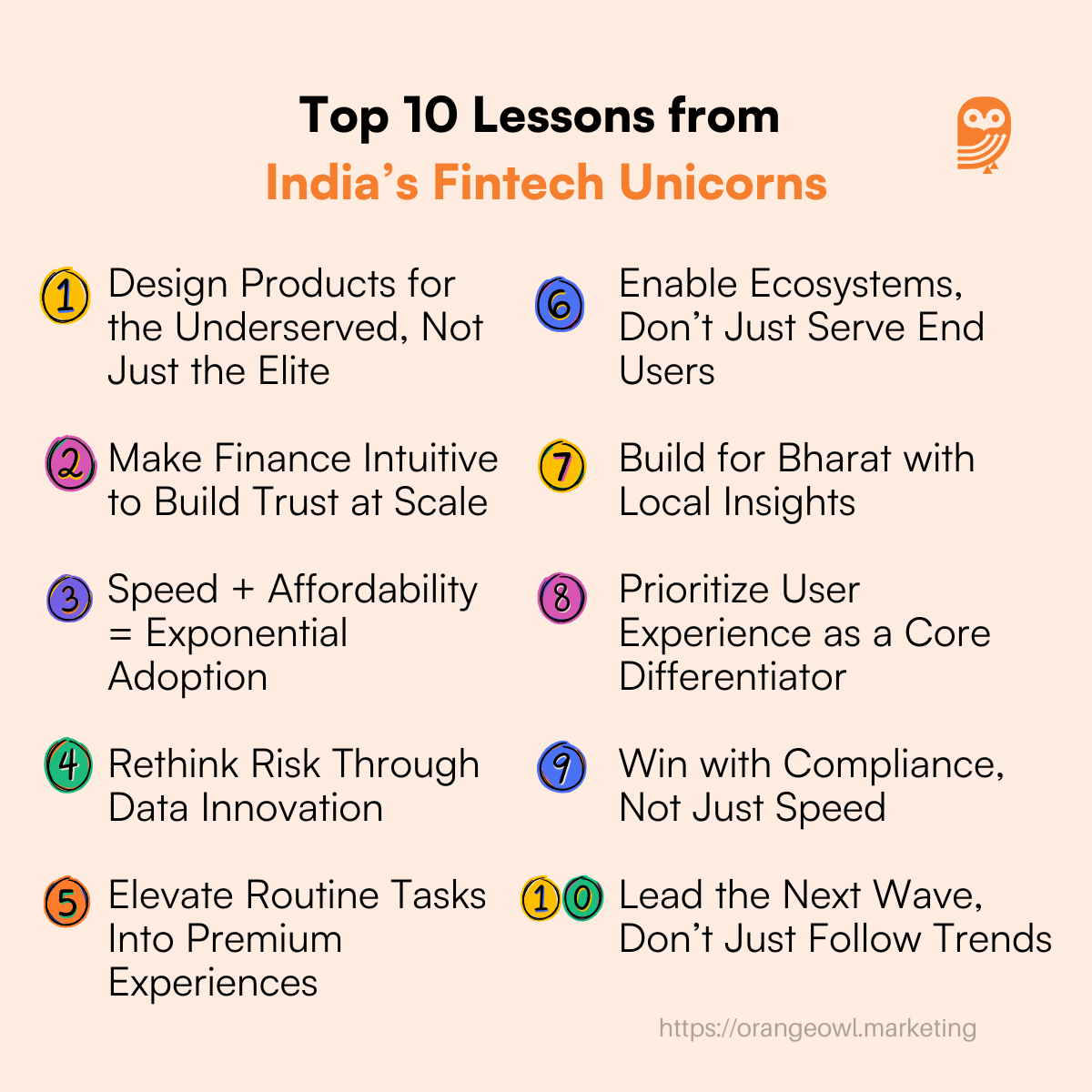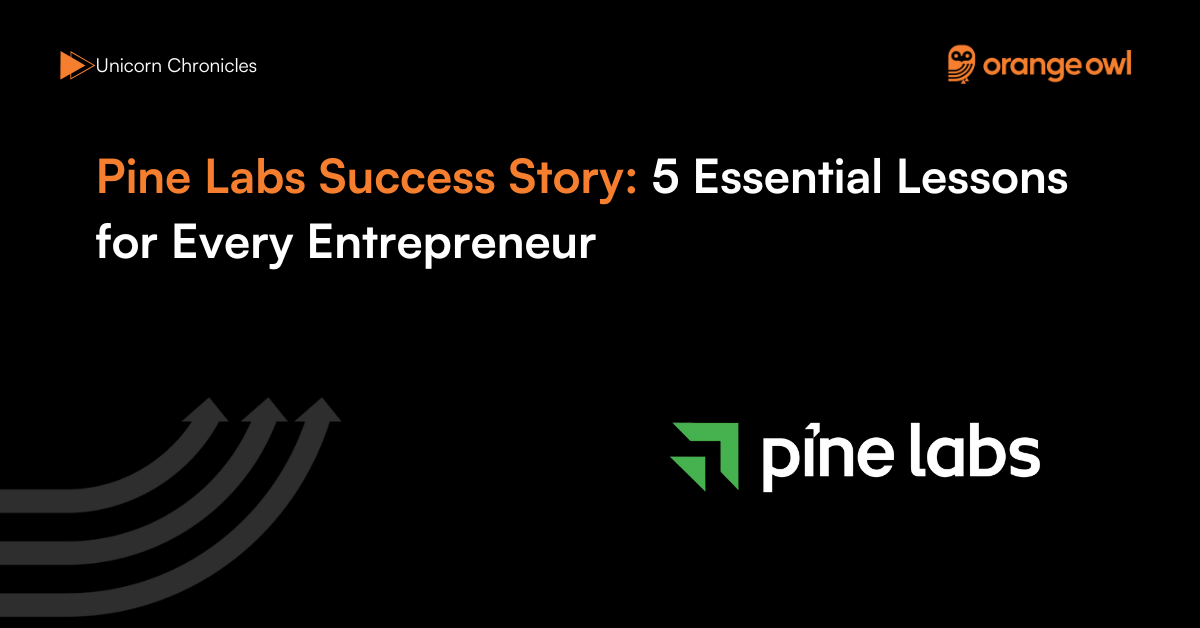10 Insightful Lessons from India’s Fintech Unicorns
Vivek Goel
May 15, 2025

Table of Contents
Introduction
India’s fintech ecosystem is rewriting the rules of finance—empowering millions with tools to save, invest, borrow, and insure with unprecedented ease. From mobile wallets and neobanks to AI-driven lending and user-friendly investment platforms, fintech startups have redefined what financial access looks like in a diverse and rapidly digitizing nation.
These companies aren’t just solving age-old problems with new technology—they’re designing intuitive user experiences, creating inclusive financial products, and unlocking entirely new markets. What makes their journeys particularly remarkable is the way they’ve combined agility, innovation, and strategic thinking to scale impact across millions, while navigating regulatory complexity and deep-rooted financial habits.
In our detailed feature, 19 Inspiring Indian Fintech Unicorn Success Stories Every Entrepreneur Must Read, we broke down the origin stories, growth strategies, and turning points of the country’s most disruptive fintech players—from Razorpay and PhonePe to CRED and Groww. These brands didn’t just build apps—they built trust, systems, and value at scale.
Now, we’ve distilled that in-depth exploration into ten sharp, actionable lessons every entrepreneur should carry forward—whether you’re solving for Bharat, building in SaaS, or chasing your first million users in healthtech. These insights go beyond buzzwords and hype—they offer grounded direction drawn from real businesses, real pivots, and real traction in the Indian startup landscape.
1. Design Products for the Underserved, Not Just the Elite
Slice redefined credit accessibility by going against the grain of India’s traditional credit industry. Instead of chasing salaried urban elites with long credit histories, it focused on students, gig workers, and young professionals—segments often overlooked due to their lack of financial documentation or formal employment records.
Slice’s onboarding process was fast, its rewards program gamified the experience, and its repayment plans were flexible enough to accommodate unpredictable incomes. This made credit not just accessible but also enjoyable for a new generation.
Lesson: Massive opportunities exist in markets that traditional players ignore. If you can identify and deeply understand underserved audiences—like first-time credit users, rural entrepreneurs, or blue-collar workers—you can design tailored products that create loyalty and scale. Simplify the journey, build trust, and add aspirational value to everyday financial experiences.
2. Make Finance Intuitive to Build Trust at Scale
Groww succeeded by doing what few investment platforms dared to: it made finance approachable. The platform was designed to eliminate the intimidation factor.
No complicated graphs, no dense financial language—just clean visuals, smooth navigation, and contextual education to guide users at every step. For millions of Indians who had never invested before, Groww became their first financial ally.
Lesson: Complexity kills adoption in fintech. Whether you’re building a savings app or a wealth management tool, your UX must instill confidence. Finance, especially for first-time users, is an emotional journey. Combine intuitive design with accessible knowledge and you’ll foster trust, engagement, and long-term habit formation at scale.
3. Speed + Affordability = Exponential Adoption
Upstox disrupted India’s traditional brokerage model by embracing two fundamental levers—speed and affordability. In a country where setting up a trading account once involved days of paperwork, Upstox offered digital KYC and account activation within minutes.
It dropped trading fees, targeted digital natives, and made the stock market less intimidating. As a result, it onboarded millions of first-time traders with minimal marketing spend.
Lesson: The combination of instant gratification and cost savings is a powerful growth engine. In fintech, where onboarding friction can be high and trust is fragile, giving users immediate access to value without upfront fees can significantly increase conversion and retention. Operational efficiency and a mobile-first approach are key to scaling fast in emerging markets.
4. Rethink Risk Through Data Innovation
Money View stepped up to tackle one of India’s biggest financial inclusion challenges—credit access for the unscored population. By harnessing alternative data—like SMS records, app usage, call logs, and digital transaction behavior—it reimagined how creditworthiness could be evaluated.
This enabled Money View to issue loans to millions of users who would otherwise be rejected by traditional banks, all while keeping NPA rates under control through intelligent underwriting models.
Lesson: In emerging markets, traditional risk models often fail large segments of the population. Fintech founders must explore non-traditional data points to gain deeper insights into user behavior and potential. If done right, alternative credit scoring can unlock billions in value while advancing financial inclusion and maintaining risk discipline.
5. Elevate Routine Tasks Into Premium Experiences
CRED didn’t just build a credit card payment app—it built a brand. By transforming the dull task of bill payment into a luxury-driven experience with high-end rewards, sleek design, and invite-only access, it flipped the conventional fintech playbook.
CRED created desire where there was once only duty, making payments feel aspirational instead of transactional.
Lesson: Even the most mundane financial tasks can be transformed into premium offerings with the right mix of aesthetics, gamification, and positioning. If your product performs a necessary but unglamorous function, consider how branding and design can shift perception, drive engagement, and create a community of loyal users who take pride in using your app.

6. Enable Ecosystems, Don’t Just Serve End Users
Perfios carved its niche not by competing for consumer eyeballs, but by strengthening the back-end capabilities of banks, NBFCs, and fintech lenders. Through its advanced data aggregation, credit decisioning, and analytics solutions, it streamlined underwriting, fraud detection, and compliance workflows—key friction points in traditional finance.
By empowering institutions with real-time insights and automation, Perfios helped improve the speed and accuracy of lending decisions across the ecosystem.
Lesson: You don’t always need to build a consumer-facing brand to make a massive impact. In fintech, the infrastructure layer—APIs, data engines, compliance tools—often powers the visible innovation. Entrepreneurs should explore how enabling others to innovate faster and more efficiently can lead to high-margin, scalable B2B business models with deep enterprise stickiness.
7. Build for Bharat with Local Insights
Startups like BharatPe and Oxyzo tapped into a goldmine by focusing on India’s long-ignored MSME sector and semi-urban/rural economies. BharatPe’s QR-based UPI solution gave small merchants free, frictionless digital payments—without needing to understand banking intricacies.
Oxyzo, on the other hand, addressed the credit gap by offering tailored, collateral-free working capital to growing MSMEs. These companies built with boots-on-ground insights, understanding the constraints of bandwidth, tech literacy, and trust in non-metro markets.
Lesson: India’s next wave of fintech growth lies outside the metros. “Bharat” is not a homogenous market—it’s a patchwork of linguistic, cultural, and economic segments. Fintech products must be localized in design, language, and value proposition to meet the real needs of Tier 2+ users and merchants. If you build for Bharat with empathy and precision, you unlock scale and stickiness that urban-centric products often miss.
8. Prioritize User Experience as a Core Differentiator
OneCard and PhonePe rose to prominence not just because of their features—but because of their obsessive focus on user experience. OneCard reimagined the credit card as a sleek, app-first product with granular control, instant issuance, and smart rewards.
PhonePe simplified UPI to a point where even a first-time smartphone user could confidently transfer money or pay bills. In both cases, intuitive design reduced onboarding friction and increased daily usage.
Lesson: In fintech, trust and usability are two sides of the same coin. A clunky, confusing interface not only frustrates users—it breeds suspicion. Smooth, delightful design builds familiarity and emotional connection, especially when handling money. Treat UX as a core product function, not a post-launch add-on, and you’ll stand out even in competitive spaces.
9. Win with Compliance, Not Just Speed
Startups like Paytm and PolicyBazaar thrived because they aligned early with regulatory frameworks in banking, insurance, and payments.
While other players tried to “move fast and break things,” these companies built strong relationships with regulators, invested in legal infrastructure, and created robust data privacy and consumer protection protocols. As a result, they were able to scale without constant disruption and earned public trust over time.
Lesson: In fintech, compliance is not just about survival—it’s a strategic advantage. India’s regulatory environment is evolving rapidly, and those who engage proactively with frameworks like RBI guidelines, IRDAI norms, or data protection laws will have a longer runway. A compliant-first mindset not only protects your business—it reassures users, partners, and investors that you’re built to last.
10. Lead the Next Wave, Don’t Just Follow Trends
Razorpay and Digit Insurance are examples of fintech unicorns that didn’t wait for the market to mature—they helped shape it. Razorpay launched when few businesses even had online payment capabilities, and it went beyond gateways to offer everything from payroll to capital loans.
Digit Insurance entered a low-trust, paperwork-heavy industry and redefined the customer experience with instant claims, app-based servicing, and transparent pricing. Both founders anticipated market shifts and invested ahead of the curve.
Lesson: Entrepreneurs who build for the future often gain a first-mover advantage that’s hard to replicate. If you can see where the market is going—towards embedded finance, insuretech, or AI-driven underwriting—start solving tomorrow’s problems today. Being early comes with risks, but it also lets you define the category, set user expectations, and build moats before the competition wakes up.
Conclusion
India’s fintech unicorns aren’t merely business success stories—they’re blueprints of strategic clarity, customer obsession, and bold innovation. They’ve challenged legacy systems, bridged financial gaps for millions, and set new benchmarks in how finance is accessed, experienced, and scaled. From Slice reimagining credit for Gen Z to Razorpay powering digital businesses end-to-end, each company has demonstrated what it truly means to align product-market fit with purpose and precision.
The ten lessons distilled from their journeys go beyond fintech—they are universal principles for building resilient, impactful startups in any sector. Whether you’re a founder, product leader, or growth strategist, understanding how these unicorns simplified complexity, embraced regulatory trust, and scaled with empathy can sharpen your own playbook.
In an era where disruption is constant and customer expectations evolve daily, the way forward is clear: build with clarity, operate with integrity, and stay ahead by anticipating change. India’s fintech leaders did just that—and so can you.


